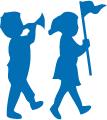Childhood Development
We have developed many effective teaching techniques over our long history, such as our traditional 100 Day program that helps children learn counting and grouping and better understand the calendar.
Here we present articles from our newsletter and other items about the child development theories and practices underlying the Nutfield Cooperative School approach.
The Write Stuff
Long before a child learn to form letters with a pencil or marker, they have taken many steps toward learning to write. Children must have many opportunities to use their hands to do various things before they can successfully print letters.
Molding with clay, using large and small Legos, picking up beads, and playing with knobbed puzzles all prepare the fingers and hands for writing. Scribbling with markers and crayons, controlling a pencil for use with a stencil, using chalk on the sidewalk, and painting with fingers and large brushes are a few of the ways children practice for later writing.
We stock our rooms with ple nty of paper, staplers, pencils, markers, and crayons, and we make sure that these materials are available for children to use whenever the choose. Children want to ”write” notes to their friends or messages to their teacher or parents. They use writing materials in their dramatic play - making signs for a store, tickets for a show, menu for a restaurant, and so on.
As children experiment, developmental stages of writing become evident. Children move from random scribbling to controlled scribbles, to random alphabet letters to consonants that represent words. Only with lots of opportunities to practice can children move through these stages.
If your child does not have a proper pencil grip, cannot purposefully manipulate a crayon, or simply shows no interest in learning to write, he or she probably is not ready to do so. Take care not to push. Children enjoy learning a new skill only when they are really ready for it. Getting ready is just as important as mastering the skill.
What are the Building Blocks?
Recent findings from emergent literacy research have demonstrated that children who easily learn to read and write have a variety of experiences with reading and writing that enable them to profit from school literacy experiences (Cunningham & Allington, 1998). In kindergarten classrooms, teachers can provide a variety of reading and writing experiences from which all children can develop these six building blocks, which are the essention to their success.
- Children learn that reading provides both enjoyment and information, and they develop a desire to learn to read and write.
- Students also learn many new concepts and add words and meaning to their speaking vocabularies.
- Children learn print concepts, including how to read from left to right, how to read from top to bottom, etc.
- Children develop phonemic awareness, including the concept of rhyme.
- Students learn to read and write some interesting-to-them words, such as “Pizza Hut,™” “cat,” and “bear.”
- Students learn some letters and sounds--usually connected to the interesting words they have learned.
Next month we will give you some activities that build these blocks.
New Hampshire Early Learning Guidelines
In October the New Hampshire Early Learning Guidelines were released by the Department of Health and Human Services. These guidelines are a tool to encourage active participation of families, early childhood educators, community members, and others involved in the care, education, and development of young children. Nutfield is embracing these guidelines as a way to continue to improve our program.
The New Hampshire Early Learning Guidelines are rooted in widely accepted theories of child development and current research. They also draw on the accumulated professional wisdom of the early childhood education field. The foundational theories and practices recognize the importance of children’s play in advancing their development and learning. The Guidelines reflect a commitment to developmentally and culturally appropriate practice.
The Guidelines are divided into seven domains. which are broad areas of children’s learning and development, and are presented in the form of guiding questions. These questions highlight the process of learning and stimulate thought about how adults can facilitate young children’s learning. The questions also encourage users to reflect on specific areas of children’s learning and development. The domains, followed by the guiding questions, are:
- Physical Development: How do young children use their bodies to explore and participate in their world?
- Social/Emotional: How do young children develop an understanding of themselves and others?
- Approaches to Learning: How do young children develop and use strategies to solve problems?
- Creative Expression/Aesthetic Development: How do young children express creativity and experience beauty?
- Communication and Literacy Development: How do young children develop an understanding of language and use it to communicate with others?
- Health and Safety: How do young children safely assess and navigate risks, and develop healthy behaviors?
- Cognitive Development: How do young children develop an understanding of how the world works?
Strands - Each of these domains contains several strands - developmental categories - that are important to consider. Strands help to further define the domain, identifying its key components. Indicators - Each domain includes specific indicators. These indicators illustrate a progression of what children think, feel and do; they are often noted by observing children at play.
Vignettes - are paired with each domain to provide simple examples of children’s learning. Many of these vignettes demonstrate the ways in which domains are interrelated and how adults can intentionally support children’s learning.
Reflections - give adults the opportunity, though memories, to recognize how powerful learning is in the early years, and that early childhood learning experiences stay with us forever.
Please take a look at the new guidelines, which are on the bulletin board across from the Nutfield office. If you would like to spend more time looking over the Guidelines you may borrow a copy from the Nutfield office.

